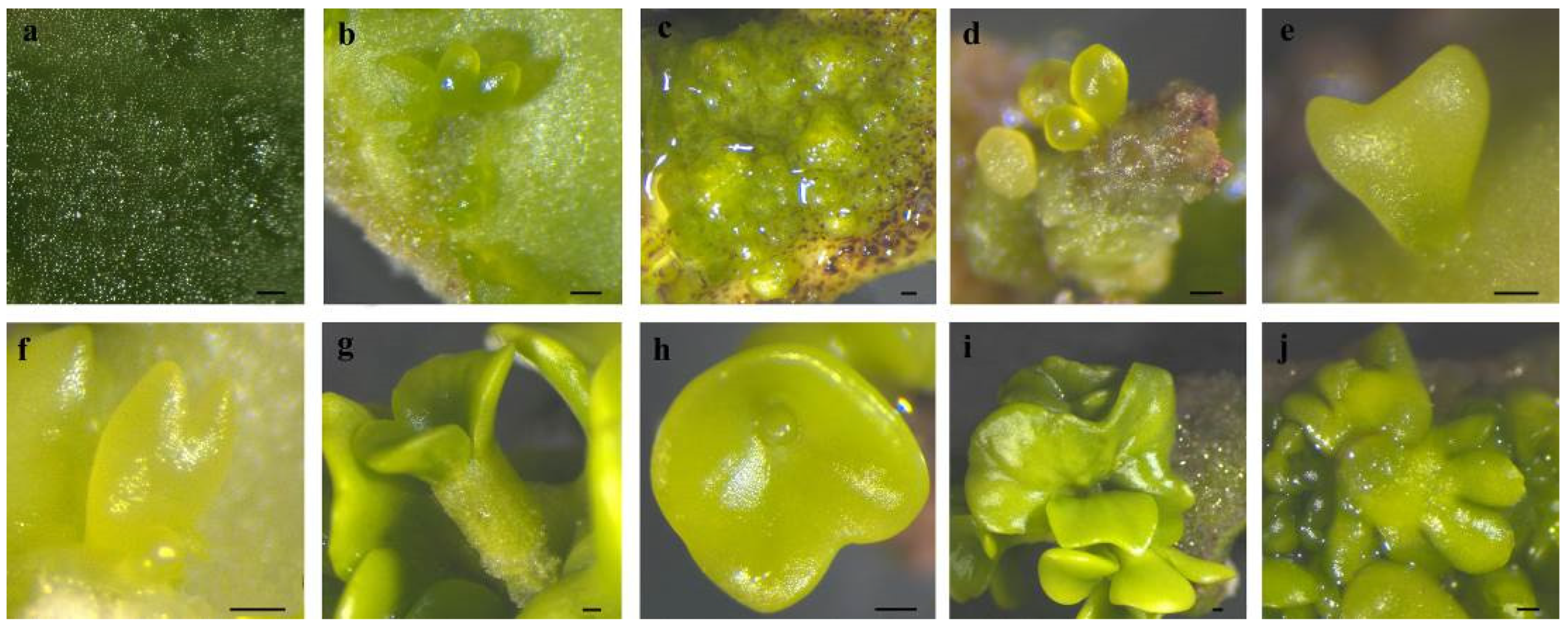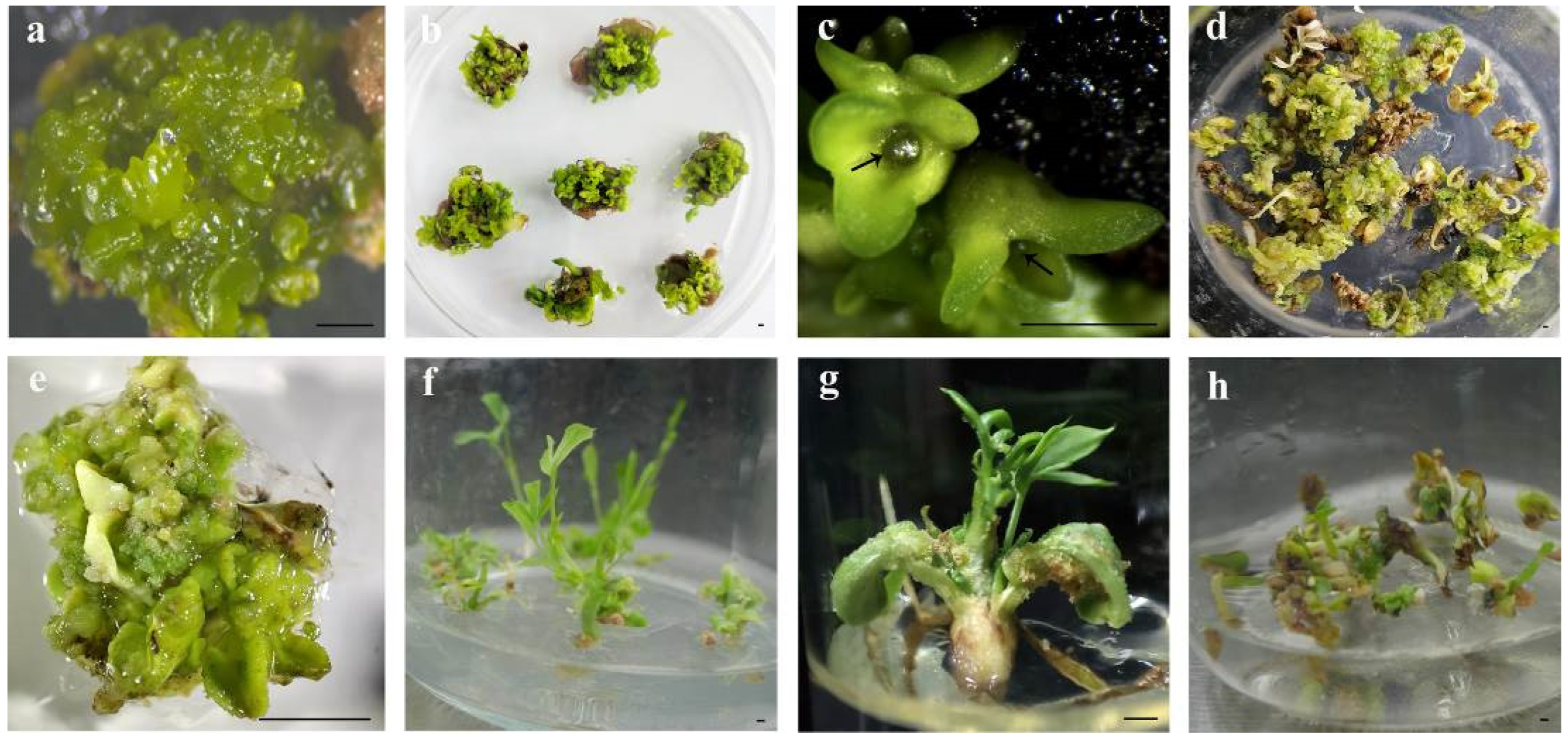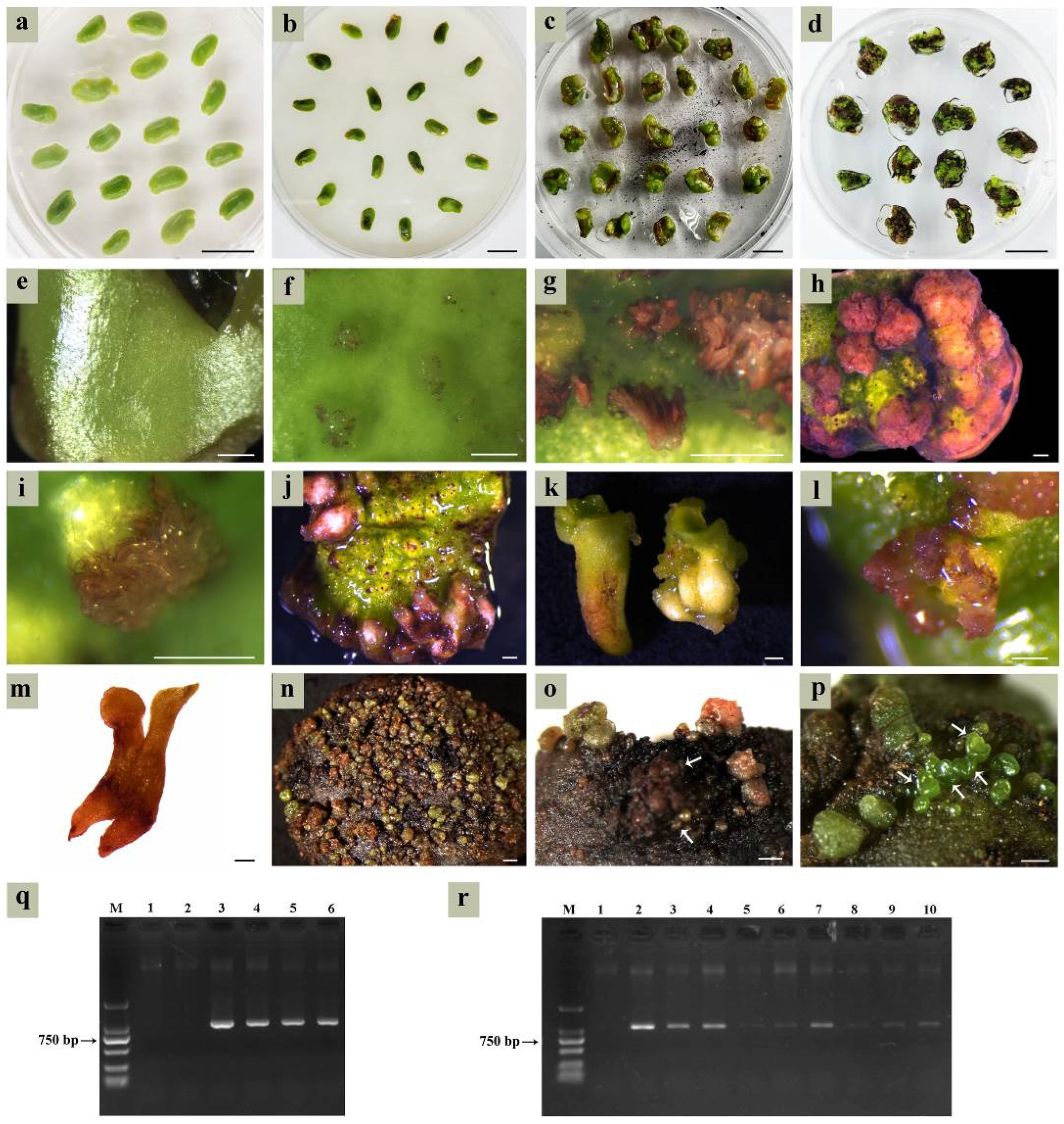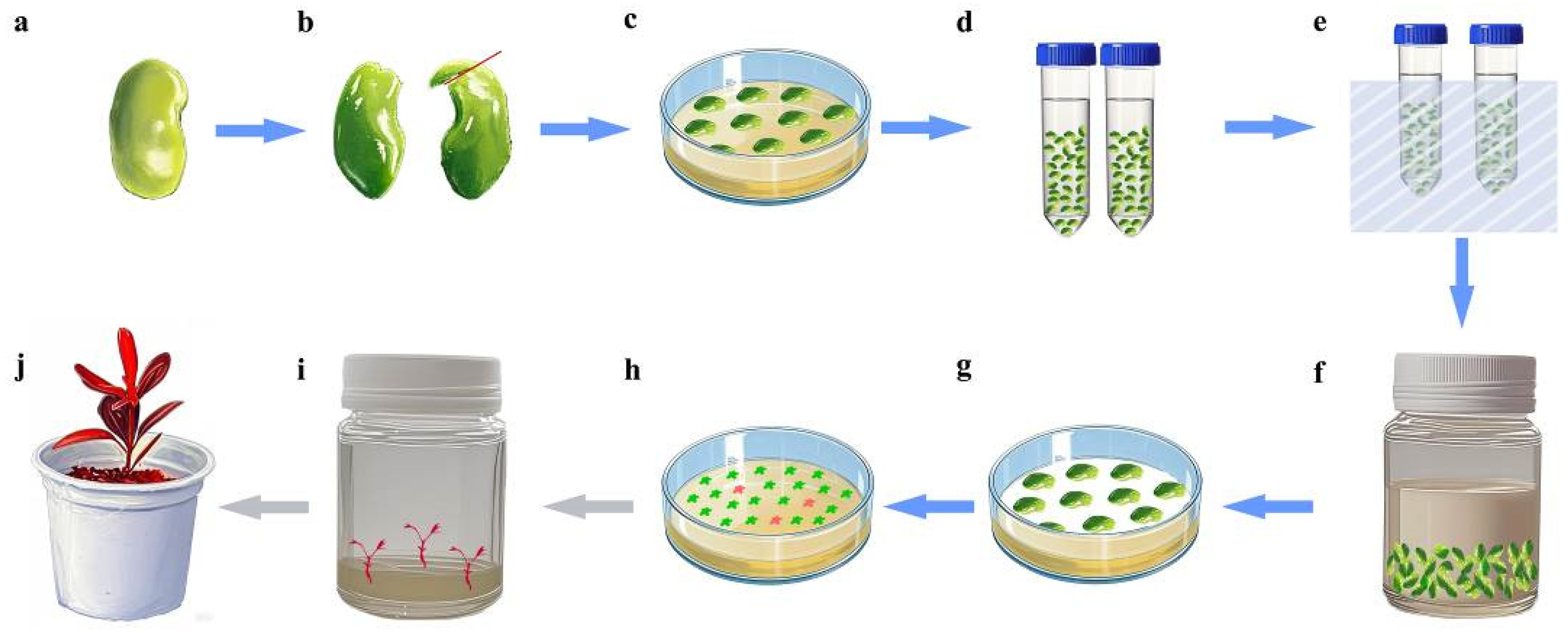Somatic Embryogenesis and Genetic Transformation of Caragana intermedia
Abstract
1. Introduction
2. Results
2.1. Effects of Cotyledon Inoculation Modes on SE
2.2. Effects of Cotyledon Development Stages on SE
2.3. Effects of PGRs on SE
2.4. Development Progress of Embryos
2.5. Germination of Cotyledon-Stage Embryos
2.6. Genetic Transformation of C. intermedia
2.7. Identification of Transgenic Materials
2.8. TRV-VIGS System Verification
3. Discussion
4. Materials and Methods
4.1. Seed Developmental Progression
4.2. Somatic Embryo Induction
4.3. Paraffin Section
4.4. Genetic Transformation
4.4.1. Reporter Genes
4.4.2. Activation of Agrobacterium
4.4.3. Preparation of Infective Bacterial Suspension
4.4.4. Cotyledons Agroinfection
4.4.5. Co-Culture and Somatic Embryos Screening
4.5. Identification of Transgenic Material
4.5.1. RNA Extraction, cDNA Synthesis, and PCR Analysis
4.5.2. Real-Time Quantitative Polymerase Chain Reaction
4.6. Image Collection and Statistics
5. Conclusions
Supplementary Materials
Author Contributions
Funding
Data Availability Statement
Acknowledgments
Conflicts of Interest
References
- Ren, Y.; Yu, X.; Xing, H.; Tretyakova, I.N.; Nosov, A.M.; Yang, L.; Shen, H. Interaction of subculture cycle, hormone ratio, and carbon source regulates embryonic differentiation of somatic cells in Pinus koraiensis. Forests 2022, 13, 1557. [Google Scholar] [CrossRef]
- Tomiczak, K.; Mikuła, A.; Niedziela, A.; Wójcik-Lewandowska, A.; Domżalska, L.; Rybczyński, J.J. Somatic embryogenesis in the family gentianaceae and its biotechnological application. Front. Plant Sci. 2019, 10, 762. [Google Scholar] [CrossRef] [PubMed]
- Kamle, M.; Baek, K.H. Somatic embryogenesis in guava (Psidium guajava L.): Current status and future perspectives. 3 Biotech 2017, 7, 203. [Google Scholar] [CrossRef] [PubMed]
- Quiroz-Figueroa, F.R.; Rojas-Herrera, R.; Galaz-Avalos, R.M.; Loyola-Vargas, V.M. Embryo production through somatic embryogenesis can be used to study cell differentiation in plants. Plant Cell Tissue Organ Cult. 2006, 86, 285–301. [Google Scholar] [CrossRef]
- Elhiti, M.; Stasolla, C. Transduction of signals during somatic embryogenesis. Plants 2022, 11, 178. [Google Scholar] [CrossRef]
- Kaviraj, C.P.; Kiran, G.; Venugopal, R.B.; Kishor, P.K.; Rao, S. Somatic embryogenesis and plant regeneration from cotyledonary explants of green gram [Vigna radiata (L.) Wilczek.]—A recalcitrant grain legume. Vitr. Cell. Dev. Biol. 2006, 42, 134–138. [Google Scholar] [CrossRef]
- Sivakumar, P.; Gnanam, R.; Ramakrishnan, K.; Manickam, A. Somatic embryogenesis and regeneration of Vigna radiata. Biol. Plant. 2010, 54, 245–251. [Google Scholar] [CrossRef]
- de Melo Souza, J.M.; de Oliveira, C.R.; da Rocha Tavano, E.C.; Soriano, L.; Martinelli, A.P. Somatic embryogenesis in citrus (Citrus spp.), var. Valencia. In Somatic Embryogenesis; Ramírez-Mosqueda, M.A., Ed.; Springer Nature: Berlin, Germany, 2022; Volume 2527, pp. 127–132. [Google Scholar] [CrossRef]
- Sivanesan, I.; Nayeem, S.; Venkidasamy, B.; Kuppuraj, S.P.; RN, C.; Samynathan, R. Genetic and epigenetic modes of the regulation of somatic embryogenesis: A review. Biol. Futur. 2022, 73, 259–277. [Google Scholar] [CrossRef]
- Liu, K.; Yang, Q.; Yang, T.; Yang, F.; Wang, R.; Cong, J.; Li, G. Transcriptome-based identification and expression profiling of AP2/ ERF members in Caragana intermedia and functional analysis of CiDREB3. Mol. Biol. Rep. 2021, 48, 7953–7965. [Google Scholar] [CrossRef]
- Wan, Y.; Mao, M.; Wan, D.; Yang, Q.; Yang, F.; Mandlaa; Li, G.; Wang, R. Identification of the WRKY gene family and functional analysis of two genes in Caragana intermedia. BMC Plant Biol. 2018, 18, 31. [Google Scholar] [CrossRef]
- Ci, Z.; He, X.; He, L.; Huang, K. The callus culture and redifferentiation of Caragana korshinkii Kom. J. Inner Mong. For. Coll. 1998, 20, 15–19. (In Chinese) [Google Scholar]
- Shen, H.; Zhai, X.; Yang, L. Somatic embryogenesis and plant regeneration of Caragana fruticosa from cotyledons of its young zygotic embryos. Plant Physiol. J. 2011, 47, 399–405. [Google Scholar] [CrossRef]
- Qiu, F.; Gao, H.W.; Xu, L. RNAi vector construction, Agrobacterium transformation and transgenic plant detection based on PAL gene of Caragana korshinkii. In Proceedings of the 8th Symposium of Agricultural Biochemistry and Molecular Biology Branch of Chinese Society of Biochemistry and Molecular Biology, Kunming, China, 1 October 2008. (In Chinese). [Google Scholar]
- Hu, J. Establishment of the Transformation System of Caragana korshinskii Kom. and Identification of CkF5H Transgenic Arabidopsis thaliana. Master’s Thesis, Inner Mongolia Agricultural University, Hohhot, China, 1 June 2014. (In Chinese). [Google Scholar]
- Yang, C. Establishment of Genetic Transformation System of Hairy Roots of Caragana intermedia and Its Optimization. Master’s Thesis, Inner Mongolia Agricultural University, Hohhot, China, 1 June 2021. [Google Scholar] [CrossRef]
- Liu, B.; Shang, X.; Zhang, X.; Shao, W.; Ren, L.; Li, G.; Zhu, M.; Wang, R. In vitro regeneration and Agrobacterium-mediated genetic transformation of Caragana korshinskii. For. Res. 2023, 3, 14. [Google Scholar] [CrossRef]
- Hiraga, S.; Minakawa, H.; Takahashi, K.; Takahashi, R.; Hajika, M.; Harada, K.; Ohtsubo, N. Evaluation of somatic embryogenesis from immature cotyledons of Japanese soybean cultivars. Plant Biotechnol. 2007, 24, 435–440. [Google Scholar] [CrossRef]
- Rathore, J.S.; Rai, M.K.; Shekhawat, N.S. Induction of somatic embryogenesis in gum arabic tree [Acacia senegal (L.) Willd.]. Physiol. Mol. Biol. Plants 2012, 18, 387–392. [Google Scholar] [CrossRef] [PubMed]
- Raza, G.; Singh, M.B.; Bhalla, P.L. Somatic embryogenesis and plant regeneration from commercial soybean cultivars. Plants 2019, 9, 38. [Google Scholar] [CrossRef]
- Karami, O.; Aghavaisi, B.; Mahmoudi Pour, A. Molecular aspects of somatic-to-embryogenic transition in plants. J. Chem. Biol. 2009, 2, 177–190. [Google Scholar] [CrossRef]
- von Arnold, S.; Sabala, I.; Bozhkov, P.; Dyachok, J.; Filonova, L. Developmental pathways of somatic embryogenesis. Plant Cell Tissue Organ Cult. 2002, 69, 233–249. [Google Scholar] [CrossRef]
- Rai, M.K.; Akhtar, N.; Jaiswal, V.S. Somatic embryogenesis and plant regeneration in Psidium guajava L. cv. Banarasi local. Sci. Hortic. 2007, 113, 129–133. [Google Scholar] [CrossRef]
- 27 Yang, X.; Zhang, X. Regulation of somatic embryogenesis in higher plants. Crit. Rev. Plant Sci. 2010, 29, 36–57. [Google Scholar] [CrossRef]
- Pulianmackal, A.J.; Kareem, A.V.; Durgaprasad, K.; Trivedi, Z.B.; Prasad, K. Competence and regulatory interactions during regeneration in plants. Front. Plant Sci. 2014, 5, 142. [Google Scholar] [CrossRef] [PubMed]
- Podwyszyńska, M.; Marasek-Ciolakowska, A. Micropropagation of tulip via somatic embryogenesis. Agronomy 2020, 10, 1857. [Google Scholar] [CrossRef]
- Ge, X.; Fan, G.; Chai, L.; Guo, W. Cloning, molecular characterization and expression analysis of a SOMATIC EMBRYOGENESIS RECEPTOR-LIKE KINASE gene (CitSERK1-like) in Valencia sweet orange. Acta Physiol. Plant. 2010, 32, 1197–1207. [Google Scholar] [CrossRef]
- Avila-Victor, C.M.; Arjona-Suárez, E.J.; Iracheta-Donjuan, L.; Valdez-Carrasco, J.M.; Gómez-Merino, F.C.; Robledo-Paz, A. Callus type, growth regulators, and phytagel on indirect somatic embryogenesis of coffee (Coffea arabica L. var. Colombia). Plants 2023, 12, 3570. [Google Scholar] [CrossRef] [PubMed]
- Campos, N.A.; Panis, B.; Carpentier, S.C. Somatic embryogenesis in coffee: The evolution of biotechnology and the integration of omics technologies offer great opportunities. Front. Plant Sci. 2017, 8, 1460. [Google Scholar] [CrossRef]
- Verdeil, J.L.; Alemanno, L.; Niemenak, N.; Tranbarger, T.J. Pluripotent versus totipotent plant stem cells: Dependence versus autonomy? Trends Plant Sci. 2007, 12, 245–252. [Google Scholar] [CrossRef]
- Delporte, F.; Pretova, A.; du Jardin, P.; Watillon, B. Morpho-histology and genotype dependence of in vitro morphogenesis in mature embryo cultures of wheat. Protoplasma 2014, 251, 1455–1470. [Google Scholar] [CrossRef]
- Zhou, X.; Zheng, R.; Liu, G.; Xu, Y.; Zhou, Y.; Laux, T.; Zhen, Y.; Harding, S.A.; Shi, J.; Chen, J. Desiccation treatment and endogenous IAA levels are key factors influencing high frequency somatic embryogenesis in Cunninghamia lanceolata (Lamb.) Hook. Front. Plant Sci. 2017, 8, 2054. [Google Scholar] [CrossRef]
- Venkataiah, P.; Bhanuprakash, P.; Suman Kalyan, S.; Subhash, K. Somatic embryogenesis and plant regeneration of Capsicum baccatum L. J. Genet. Eng. Biotechnol. 2016, 14, 55–60. [Google Scholar] [CrossRef]
- Singh, R.; Rai, M.K.; Kumari, N. Somatic embryogenesis and plant regeneration in Sapindus mukorossi Gaertn. from leaf-derived callus induced with 6-Benzylaminopurine. Appl. Biochem. Biotechnol. 2015, 177, 498–510. [Google Scholar] [CrossRef]
- Azizi-Dargahlou, S.; Pouresmaeil, M. Agrobacterium tumefaciens-Mediated Plant Transformation: A Review. Mol. Biotechnol. 2024, 66, 1563–1580. [Google Scholar] [CrossRef]
- Wang, X.; Chen, S.; Zhang, H.; Luo, P.; Zhou, F.; Zeng, B.; Xu, J.; Fan, C. Agrobacterium-mediated genetic transformation of the most widely cultivated superior clone Eucalyptus urophylla × Eucalyptus grandis DH32-29 in Southern China. Front. Plant Sci. 2022, 13, 1011245. [Google Scholar] [CrossRef] [PubMed]
- Jadhav, M.P.; Katageri, I.S. Agrobacterium tumefaciens mediated genetic transformation in coker-312 (Gossypium hirsutum L.) using hypocotyls explants. Int. J. Curr. Microbiol. App. Sci. 2017, 6, 2771–2779. [Google Scholar] [CrossRef]
- Zhang, X.; Wu, Q.; Lin, S.; Zhang, Z.; Wang, Z.; Wang, Q.; Yan, X.; Bendahmane, M.; Bao, M.; Fu, X. Regeneration and Agrobacterium-mediated genetic transformation in Dianthus chinensis. Sci. Hortic. 2021, 287, 110279. [Google Scholar] [CrossRef]
- Han, J.L.; Wang, H.; Ye, H.C.; Liu, Y.; Li, Z.Q.; Zhang, Y.; Zhang, Y.S.; Yan, F.; Li, G.F. High efficiency of genetic transformation and regeneration of Artemisia annua L. via Agrobacterium tumefaciens-mediated procedure. Plant Sci. 2005, 168, 73–80. [Google Scholar] [CrossRef]
- Zhang, B.; Zhao, X.; Zhang, L.; Liu, H.; Zhu, C.; Ma, Z. Agrobacterium tumefaciens mediated genetic transformation of Tripterygium wilfordii and its application to enhance the accumulation of triptolide. Ind. Crop. Prod. 2022, 187, 115506. [Google Scholar] [CrossRef]
- Li, X.; Jiang, Z.; Shen, Y.; Li, F.; Yu, X.; Qu, S. In vitro regeneration and Agrobacterium tumefaciens-mediated genetic transformation of D. lotus (Diospyros lotus L.). Sci. Hortic. 2018, 236, 229–237. [Google Scholar] [CrossRef]
- He, Y.; Zhang, T.; Sun, H.; Zhan, H.; Zhao, Y. A reporter for noninvasively monitoring gene expression and plant transformation. Hortic. Res. 2020, 7, 152. [Google Scholar] [CrossRef]
- Zhang, J.; Yu, D.; Zhang, Y.; Liu, K.; Xu, K.; Zhang, F.; Wang, J.; Tan, G.; Nie, X.; Ji, Q.; et al. Vacuum and co-cultivation agroinfiltration of (Germinated) seeds results in Tobacco Rattle Virus (TRV) mediated whole-plant Virus-Induced Gene Silencing (VIGS) in wheat and maize. Front. Plant Sci. 2017, 8, 393. [Google Scholar] [CrossRef]
- Yang, Q.; Fan, Y.; Luo, S.; Liu, C.; Yuan, S. Virus-induced gene silencing (VIGS) in Hydrangea macrophylla and functional analysis of HmF3′5′H. Plants 2024, 13, 3396. [Google Scholar] [CrossRef]
- Livak, K.J.; Schmittgen, T.D. Analysis of relative gene expression data using real-time quantitative PCR and the 2−ΔΔCT method. Methods 2001, 25, 402–408. [Google Scholar] [CrossRef] [PubMed]






| Weeks After Flowering (WAF) | Seed Length (mm) | Seed Width (mm) | Cotyledon-Stage Embryo Induction Rate (%) | Number of Cotyledon-Stage Embryos |
|---|---|---|---|---|
| 1 | 1.52 ± 0.05 h | 0.72 ± 0.01 i | 0.00 g | 0.00 e |
| 2 | 1.78 ± 0.02 g | 1.09 ± 0.03 h | 0.00 g | 0.00 e |
| 3 | 4.98 ± 0.04 f | 1.99 ± 0.06 g | 0.00 g | 0.00 e |
| 4 | 5.57 ± 0.11 e | 2.85 ± 0.05 f | 5.66 ± 0.22 e | 0.87 ± 0.09 d |
| 5 | 7.05 ± 0.11 d | 4.16 ± 0.03 d | 37.67 ± 0.46 c | 7.51 ± 0.30 c |
| 6 | 7.55 ± 0.01 c | 4.33 ± 0.02 c | 55.00 ± 0.48 b | 9.58 ± 0.09 b |
| 7 | 8.37 ± 0.02 b | 4.58 ± 0.05 b | 57.14 ± 0.40 a | 11.80 ± 0.42 a |
| 8 | 8.89 ± 0.05 a | 4.86 ± 0.07 a | 12.31 ± 0.17 d | 1.25 ± 0.05 d |
| 9 | 9.02 ± 0.05 a | 4.96 ± 0.01 a | 1.48 ± 0.18 f | 0.35 ± 0.03 e |
| 10 | 7.02 ± 0.13 d | 3.41 ± 0.05 e | 0.00 g | 0.00 e |
| Treatment Number | NAA (mg/L) | 6-BA (mg/L) | Cotyledon-Stage Embryo Induction Rate (%) | Number of Cotyledon-Stage Embryos | ||||||
|---|---|---|---|---|---|---|---|---|---|---|
| 5 WAF | 6 WAF | 7 WAF | Means | 5 WAF | 6 WAF | 7 WAF | Means | |||
| 1 | 3 | 3 | 79.17 ± 0.31 a | 53.89 ± 0.79 b | 34.72 ± 1.30 e | 55.93 ± 6.45 b | 11.98 ± 0.95 bc | 8.38 ± 0.23 bc | 11.56 ± 0.39 bc | 10.64 ± 0.64 b |
| 2 | 3 | 5 | 58.33 ± 1.08 c | 65.00 ± 1.46 a | 41.67 ± 1.03 cd | 55.00 ± 3.52 bc | 10.04 ± 0.10 d | 10.20 ± 0.46 a | 6.88 ± 0.97 e | 9.04 ± 0.62 cd |
| 3 | 3 | 7 | 54.17 ± 0.60 cd | 40.74 ± 1.60 c | 30.56 ± 1.24 e | 41.82 ± 3.47 f | 10.61 ± 0.47 cd | 7.55 ± 0.65 c | 5.35 ± 0.44 e | 7.84 ± 0.81 ef |
| 4 | 5 | 3 | 64.88 ± 1.43 b | 55.56 ± 1.78 b | 54.76 ± 1.85 b | 58.40 ± 1.83 a | 15.23 ± 0.78 a | 9.82 ± 0.55 ab | 11.35 ± 0.48 bc | 12.13 ± 0.86 a |
| 5 | 5 | 5 | 37.67 ± 2.50 e | 55.00 ± 0.90 b | 57.14 ± 0.73 b | 49.94 ± 3.18 e | 7.51 ± 0.24 e | 9.58 ± 0.54 ab | 11.80 ± 0.49 bc | 9.63 ± 0.66 c |
| 6 | 5 | 7 | 51.33 ± 0.72 d | 25.56 ± 1.93 d | 40.21 ± 0.44 d | 39.03 ± 3.78 g | 8.33 ± 0.07 e | 5.89 ± 0.55 de | 10.30 ± 0.39 cd | 8.17 ± 0.67 de |
| 7 | 7 | 3 | 54.53 ± 1.23 cd | 43.06 ± 1.05 c | 55.83 ± 2.56 b | 51.14 ± 2.21 de | 12.74 ± 0.94 b | 6.85 ± 0.75 cd | 12.34 ± 0.92 b | 10.64 ± 1.05 b |
| 8 | 7 | 5 | 67.50 ± 1.80 b | 28.61 ± 0.96 d | 61.90 ± 1.72 a | 52.67 ± 6.12 cd | 14.83 ± 0.41 a | 5.05 ± 0.08 e | 15.63 ± 0.75 a | 11.84 ± 1.72 a |
| 9 | 7 | 7 | 40.00 ± 1.75 e | 25.28 ± 0.26 d | 46.16 ± 2.13 c | 37.15 ± 3.20 g | 4.87 ± 0.20 f | 7.01 ± 0.20 cd | 9.28 ± 0.23 d | 7.05 ± 0.65 f |
| Number | Research Purpose | Medium Components |
|---|---|---|
| 1# | Effects of cotyledon inoculation modes on SE | MS + 5 mg/L NAA + 5 mg/L 6-BA + 30 g/L sucrose + 7 g/L agar + 500 mg/L hydrolyzed casein, pH 5.8 |
| 2# | Effects of different PGR combinations on SE | MS + (3, 5, 7) mg/L NAA + (3, 5, 7) mg/L 6-BA + 30 g/L sucrose + 7 g/L agar + 500 mg/L hydrolyzed casein, pH 5.8 |
| 3# | Germination of cotyledon-stage embryos | 1/2 MS + (0, 0.005, 0.05, 0.01) mg/L NAA + 30 g/L sucrose + 7 g/L agar, pH 5.8; |
| MS, HS-MS, 1/4 MS + 30 g/L sucrose + 7 g/L agar, pH 5.8 | ||
| 4# | Co-culture | MS + 5 mg/L NAA + 3 mg/L 6-BA + 8 g/L agar + 30 g/L sucrose + 200 µM AS, pH 5.4 |
| 5# | Somatic embryo selection | MS + 5 mg/L NAA + 3 mg/L 6-BA + 8 g/L agar + 30 g/L sucrose + 500 mg/L hydrolyzed casein + 400 mg/L Cef + 13 mg/L Hyg, pH 5.8 |
| 6# | Cotyledon-stage embryo differentiation | HS-MS + 30 g/L sucrose + 7 g/L agar + 250 mg/L Cef + 50 mg/L Kan, pH 5.8 |
Disclaimer/Publisher’s Note: The statements, opinions and data contained in all publications are solely those of the individual author(s) and contributor(s) and not of MDPI and/or the editor(s). MDPI and/or the editor(s) disclaim responsibility for any injury to people or property resulting from any ideas, methods, instructions or products referred to in the content. |
© 2025 by the authors. Licensee MDPI, Basel, Switzerland. This article is an open access article distributed under the terms and conditions of the Creative Commons Attribution (CC BY) license (https://creativecommons.org/licenses/by/4.0/).
Share and Cite
Tian, J.; Zhu, J.; Deng, X.; Zhu, X.; Wang, R.; Li, G. Somatic Embryogenesis and Genetic Transformation of Caragana intermedia. Plants 2025, 14, 1545. https://doi.org/10.3390/plants14101545
Tian J, Zhu J, Deng X, Zhu X, Wang R, Li G. Somatic Embryogenesis and Genetic Transformation of Caragana intermedia. Plants. 2025; 14(10):1545. https://doi.org/10.3390/plants14101545
Chicago/Turabian StyleTian, Ju, Jialei Zhu, Xiaohan Deng, Xu Zhu, Ruigang Wang, and Guojing Li. 2025. "Somatic Embryogenesis and Genetic Transformation of Caragana intermedia" Plants 14, no. 10: 1545. https://doi.org/10.3390/plants14101545
APA StyleTian, J., Zhu, J., Deng, X., Zhu, X., Wang, R., & Li, G. (2025). Somatic Embryogenesis and Genetic Transformation of Caragana intermedia. Plants, 14(10), 1545. https://doi.org/10.3390/plants14101545







